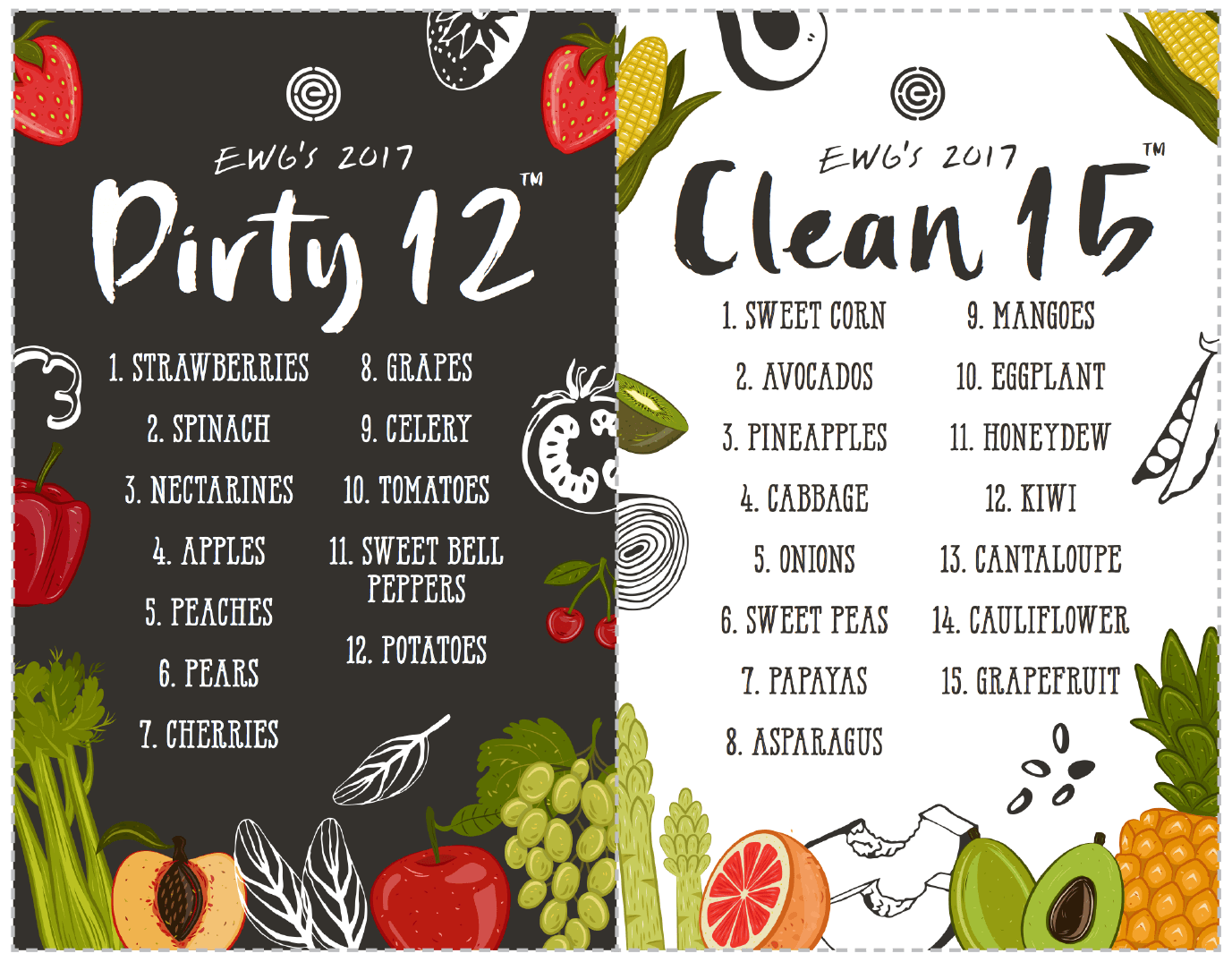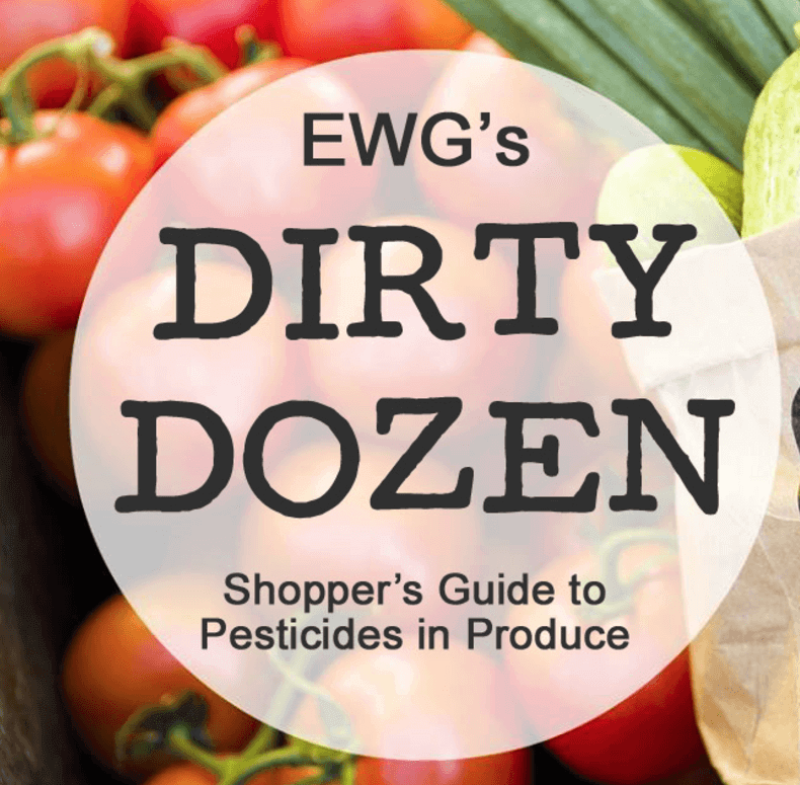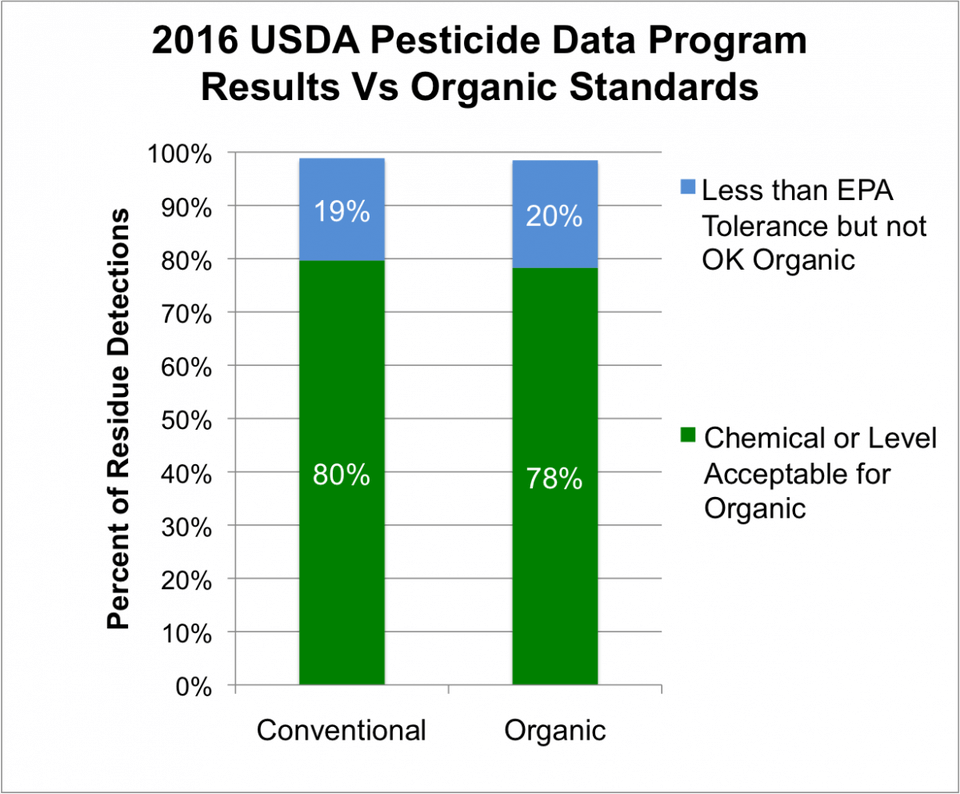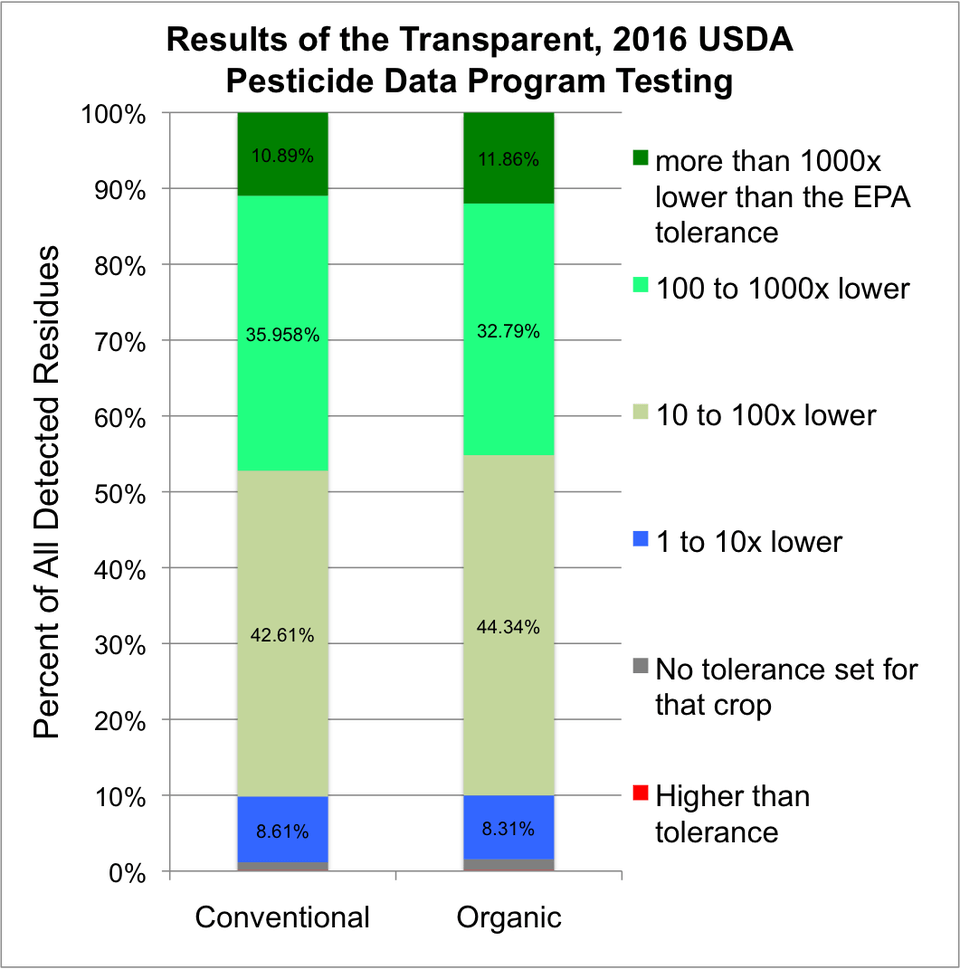Writer’s note: This article has been corrected on 5/17 because of a data error that was brought to my attention – there is more information about that at the end of the post
Consumers have a legitimate desire for transparency when it comes to their food – particularly when it comes to the issue of pesticide residues. Consumers can get exactly that kind of information from a yearly publication from the USDA’s Pesticide Data Program, or PDP. Consumers deserve to get this information since they are the taxpayers who fund EPA regulation of crop protection products. This USDA, PDP program essentially “checks up” on how well that regulation is working. Fortunately, what the data shows is very encouraging in terms of the system and food safety.What consumers don’t deserve is the way that the very transparency of the PDP is misused to manipulate them through a fear-based marketing scheme funded by certain “Big Organic” companies. This annual “analysis” of the PDP data is known as the “Dirty Dozen List,” and it is published by the Environmental Working Group or EWG. EWG purports to tell you which foods you most need to buy organic to avoid pesticide residues. Their assessment methods have been repeatedly and completely debunked by real toxicologists, but they persist in using this list to scare people into buying organic. I am glad that the USDA perseveres with transparency in spite of this chronic abuse because the real data demonstrates the utter fallacy of the EWG fear mongering.
 Since 1990 the USDA has responded to consumer interest in residues by conducting an extensive monitoring program. They collect around ten thousand food items from the US distribution system (mostly fruits and vegetables but also sometimes grains, milk, eggs, baby food etc). They take those samples back to labs and conduct extremely sensitive tests for the presence of residues related to the chemicals that farmers use to protect the productivity and quality of their crops. For the 2016 program they collected samples of these foods:
Since 1990 the USDA has responded to consumer interest in residues by conducting an extensive monitoring program. They collect around ten thousand food items from the US distribution system (mostly fruits and vegetables but also sometimes grains, milk, eggs, baby food etc). They take those samples back to labs and conduct extremely sensitive tests for the presence of residues related to the chemicals that farmers use to protect the productivity and quality of their crops. For the 2016 program they collected samples of these foods:
- Fresh: Apples, Cherries, Cranberries, Cucumbers, Grapefruit, Grapes, Green Beans, Lettuce, Oranges, Pears, Potatoes, Spinach, Strawberries, Sweet Potatoes, Tomatoes.
- Processed: Apples Sauce, Frozen Cranberries, Canned Olives, Canned Tomatoes
As has been the case for many years, the 2016 results released by USDA confirm the fact that between EPA and state level regulation and grower compliance, consumers can confidently enjoy the US food supply free from concerns about pesticide residues. The results are summarized on the USDA Pesticide Data Program website in the form of links to high-level assessments by governmental experts. There is a downloadable webinar on the topic. There is also a very detailed report (110 pages plus appendices) that breaks down the data by commodity, source (domestic, importer country…), and by specific chemicals. Again, the take-away is documentation of how well the system is working to protect American consumers.
The deepest level of transparency of the PDP is in the form of a 10,365 row table of information about the samples and a 2.2 million row table about the testing results for the 2-300 specific chemicals looked for in each sample (most of those results were negative for detection of the chemical in question). For several years I have taken advantage of that transparent resource.
For the cases where a residue can be detected, the question of safety at the consumer level has to be based on knowing how much of which specific chemical or chemical metabolite is found on which specific kind of food. This is because the EPA conducts extensive “risk assessments” using everything known about the toxicity profile of each crop protection chemical and uses that to set a very conservative, crop-by-crop “tolerance” which is a level below which they can confidently say that the residue represents no health risk to the consumer. This generally represents around a 100-fold margin of safety from any known effects of the chemical. Elsewhere around the world these thresholds are known as MRLs.
For the most recent year of released data (2016), only 0.15% of the chemical “detections” were above the EPA tolerance threshold and most of those were only slightly above. About 1% of the detections were for compounds for which there are not specific tolerances for the crop in question – but all of these were at extremely low levels and not deemed to be of concern by the experts. So 98.8% compliance with tolerances is clearly an A++ grade for those who produce our food both in the US and in countries from which we import many items.
In its analysis for the “Dirty Dozen List”, the EWG treats each “detection” as a problem irrespective of the specifics of which chemicals is found at what concentration. It then uses that science-free version of the data to “guide” consumers about which foods are most important to “buy organic” as a residue avoidance strategy.
What EWG neglects to mention is that there are pesticide residues detected on the organic foods that happen to be picked up in the USDA sampling program. Of the 10,365 samples tested from 2016, 4.8% were organic and 95% were “conventional” with the remainder having some other type of claim. On average there were 0.75 detections of residue per organic sample (379 total detections among 501 samples). Many consumers believe that organic means “no pesticides” which is not at all true, but that is a “convenient fiction” that is rarely addressed by organic marketers. Farmers of organic crops definitely need to protect them from pests and they have an extensive list of “natural products” and biological control agents that they can use (options also often used by “conventional” farmers). However, most of those options are not something that can be detected using the analytical chemical methods employed in the PDP labs. Only the fermentation-produced chemical Spinosad and the plant extract Pyrethrin, both approved for organic, are picked up in the methodology mainly designed to detect synthetic chemicals.
The fact that most of the organic-approved pesticides go unmonitored isn’t really a problem because with the possible exception of very old, mineral-based fungicides like copper sulfate these are things with very little or no toxicity to people. So, 59 of the 379 pesticide “detections” on organic PDP samples were of organic-approved products. The rest are all “synthetic” chemicals, which certainly does not mean they are scary, but they are not things that are allowed to be applied to USDA organic crops. Seventy-five different synthetic chemicals were detected at low levels on the organic samples.
Once again, 99.85% of these residues on organic samples were found at levels below the EPA tolerance so its not a safety issue with organic just as it isn’t with the identical 99.85% “below tolerance” detections for conventional. However, these results certainly don’t fit with overall organic branding. I have some ideas for why those low level synthetic residues might be there on organic items, but I will leave it up to the USDA organic program or those produce organic to explain this phenomenon.
Now, the part of the USDA that oversees organic certification (National Organic Program – NOP) has set a somewhat arbitrary standard that if a synthetic pesticide residue is found at less that 5% of the EPA tolerance, it is considered to have been an “unintentional” event and wouldn’t disqualify the item as organic if this were part of a compliance screening effort (that is a program that USDA-NOP does conduct separate from the PDP, but in that case the results are not published in any transparent way).
Well, most of the residues (78.3%) detected on the 2016 organic samples were either spinosad or below the 5% threshold – thus they are not officially a problem. Interestingly, 79.7% of the “conventional” samples met those same criteria. There were; however, 20.2% of the synthetic detections on organic that were over the 5% of tolerance threshold – once again essentially the same as the 19.2% of detections for conventional in that same safe, but not ok for organic range.
So what the transparent, publicly generated data tells us is this: “enjoy our food supply without worries about health effects from pesticide residues, and by the way there really isn’t any meaningful difference in this regard between organic and conventional.” Neither category is “dirty” and in fact they are quite similar in the details of how clean they are.
But there is one more important conclusion that can be drawn from a deep dive into the transparency of the PDP. Not only are the residues on conventional samples below tolerance, 43% are 10 to 100 times lower than the already conservative tolerance. 36% are 100 to 1000 times below the tolerance. 11% are more than 1000 times below the tolerance. (The same categories for organic were 44%, 33% and 12% – again, remarkably similar to the “conventional”).
Transparency of the type that the USDA exhibits with its Pesticide Data Program does run the risk of misuse by parties with an economic incentive to mislead consumers. But ultimately that same transparency also allows us to know what the data really says. It turns out that the whole idea that consumers should worry about foods that are “dirty” because of chemical residues is false. The narrative that organic is really different in that regard also turns out to be false. Bottom line: enjoy our diverse, safe, affordable food supply! Perhaps the conclusion is well expressed by the Weird Al Yankvich parody song, “Just Eat It!”
A Further Explanation of the Data Error in the Original Posts on This Topic:
On March 25 and May 10th I posted articles about the USDA’s annual Pesticide Data Program (PDP) that takes a look at chemical residues on various commodities in the US food supply (mainly fruits and vegetables). I described the program and its various levels of published summaries as a valuable example of a transparent data resource, which it certainly is. Unfortunately I made an error in my analysis, using the wrong year’s “sample table” (10,365 rows) to identify which of the residue detections in the “results table” were from organic or conventional sources (31,981 rows drawn from a 2.2 million row table). This meant that I erroneously overstated the number of pesticide detections on organic samples. I had reported an average of 2.6 detections/organic sample and the actual number is 0.75 detections per sample vs 3.2 detections/sample for conventional. Journalist Tamar Haspel brought this issue to my attention. She was skeptical about the similarity of detection frequencies I had described for organic and made the effort to check the original data. I very much appreciate her persistence on this question. I want to apologize for that error and any wrong conclusions that came from that. I do this analysis of the data each year as a personal project unrelated to my consulting and ag communications jobs, so the responsibility for this error rests entirely on me. I am striving to remove the content that was based on the error, let people know about the mistake, and with this post, get the analysis right.
Steve Savage is an agricultural scientist and consultant whose previous employers include Colorado State University and DuPont. Follow him on his blog, Applied Mythology, or Twitter @grapedoc.
This article was originally published at Forbes as “In Defense Of An Important Example Of Food System Transparency” and has been republished with permission.

































